Weeks of drought can occasionally be alternated with heavy showers in which large amounts of water fall from the sky in a short time. Strawberry growers cannot do anything about it, but can they do something with it? Yes, to ensure that they collect as much water as possible.
Growers of protected greenhouse crops have long been familiar with the collection and processing of drainage streams. In Flanders, strawberry growers now have to comply with new rules: from January 2021 installing a first flush system is obligated for growers with tray or container fields. This way they ensure that nutrient-rich drain water from the open field doesn't get lost in the surface water.
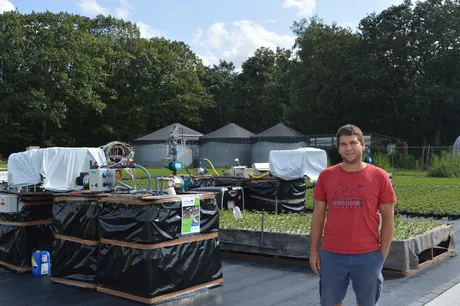
Dieter Baets before the three test set-ups, which, as you can see in the photo below, are located in the middle of the large tray field.
Filtering and disinfecting
All that water, of course, must be properly filtered and disinfected. Only then can a grower give it back to his crop. To help those growers and to be able to advise about investing in the right installation, testing was carried out at Proefcentrum Hoogstraten.
In July, three filtration set-ups were installed on the existing strawberry tray field to find out which combination of filtration and/or disinfection works best. "Both growers with tray or container fields, but also growers with lettuce on gutters can benefit from our research findings," according to Dieter Baets, strawberry researcher at the Hoogstraten Test Center and involved in the project. The same test set-up can also be found at the Proefstation voor de Groenteteelt in Sint-Katelijne-Waver.
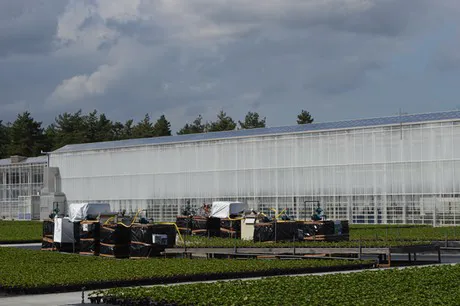
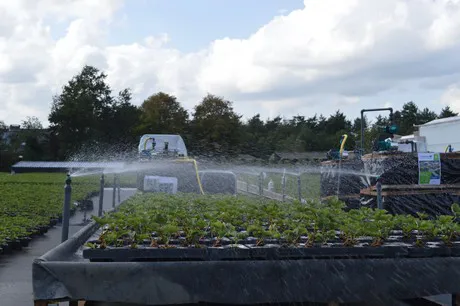
After the sprayers had been switched on and the water has been collected, the filtration starts.
Fabric filter and cloth filters
Of the three set-ups, part of the Interreg Flanders-Netherlands project Recupa, two are equipped with a fabric filter. Cloth filters from Aqua D&S, known for combating legionella in other sectors and entered into agriculture and horticulture because of the increasing interest in water, combined with a vibrating screen from the same company.
Dieter: “What immediately struck me compared to other screen filters is the extra high edge on the fabric. Maybe not rocket science, but it is something I have never seen before with other fabric filters. That higher edge ensures that the water on the cloth, even if the cloth is full of dirt, does not overflow immediately and so enters the silo unfiltered."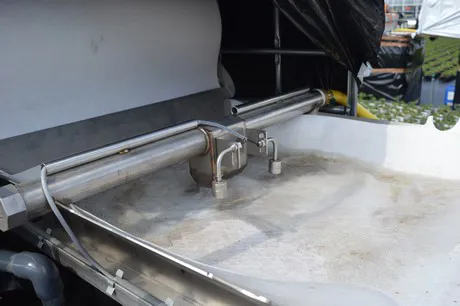
The fabric filter, with the two floats hanging above the water surface
Fabric filter
A float above the fabric filter prevents the Aqua D&S filter from overflowing. “If the water level rises and hits the float, the float shoots up, after which the cloth moves up twenty centimeters. This means that again there is clean cloth on the filter and the filtration can continue”. That's Dieter's experience in the test that will continue until December 2019.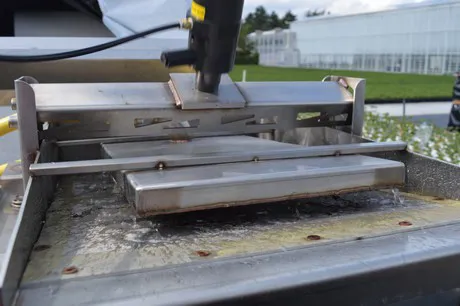
The vibrating screen removes the first dirt from the water.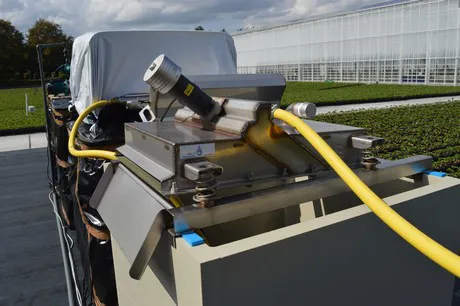
Vibrating screens
Rianne de Baar from Aqua D&S points out that the addition of a vibrating screen in any case extends the life of the cloth. That is why such a vibrating screen has been added to two of the three set-ups in Hoogstraten. The first dirt is vibrated out of the water on the 75 micron screen. Dirt that certainly is abundantly present in the cultivation of strawberries in trays on coco and white peat substrate from the first irrigation cycle on the 18-square-meter mini-tray field. “We are testing the fabric filters in a variant of 5 microns and 20 microns. We drip stabilized hydrogen peroxide with the 5 micron cloth, while we use UV light for disinfection with the 20 micron cloth.”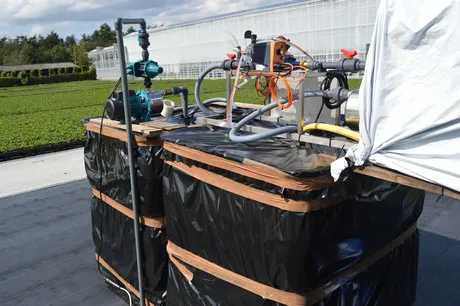
In one of the three set-ups, hydrogen peroxide is added as drops as the last disinfection step.
Stone wool
And what about the third set-up? “This is where the strawberry plants grow on stone wool substrate blocks. This causes less dirt, which means that here we only disinfect the water with UV light in the test. You might compare it with the difference between pot plant cultivation and tomato cultivation. A tomato grower normally also has less coarse, organic dirt in his irrigation water, while a pot plant grower, but also a strawberry grower with a tray field, has much more organic dirt in his drain water.”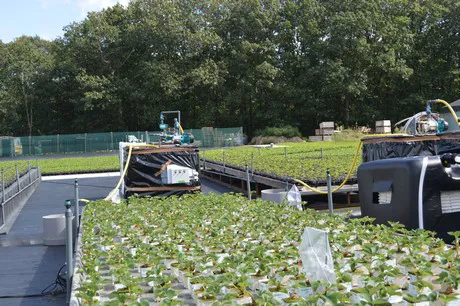
Strawberry plants on substrate blocks of stone wool
Black foil
Anyone who has studied the set-ups in the photos above may have noticed something else besides the technical gadgets. Black foil. Dieter, smiling after doing a round past the large filtration set-up for daily practice on the tray field in Hoogstraten: “Yes, I still wanted to explain that, there is a reason for foil. Because we are dealing with nutrient-rich water and because the set-up is outside and therefore is exposed to sunlight, the algae grow faster than we would like. Black foil helps to reduce algae growth."
A typical detail to take into account when refining the recirculation of water at growers. “As a testing center, we are in a position to test without directly endangering commercial cultivation. Our challenge is to test the filtration and disinfection set-ups and optimize them together with the involved suppliers."
For more information: 
Aqua Development & Solutions B.V.
www.aquadns.nl
[email protected]
Proefcentrum Hoogstraten 
www.proefcentrum.be
[email protected]
